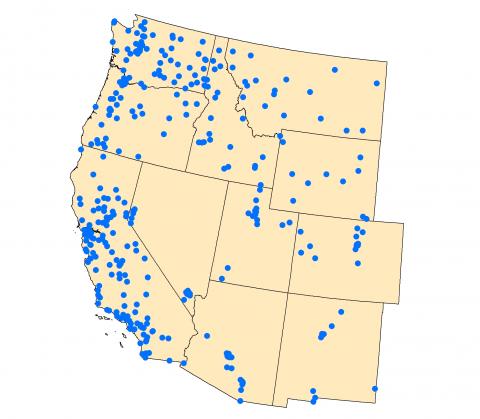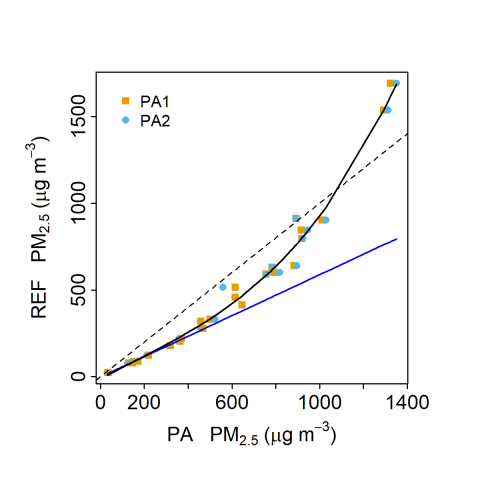Wildland fires produce significant air pollution and real-time measurements of these pollutants are critical for mitigating the human health impacts of smoke. With climate change increasing the severity of the western U.S. wildfire season, there is an urgent need for new air pollution measurement technologies to reduce coverage gaps in existing air monitoring networks. The RMRS and USEPA have partnered in a multi-year effort to advance the development of new air measurement technologies for real-time smoke monitoring and to evaluate the performance of existing instrumentation in smoke impacted environments.
Wildland fires are a recurring, episodic source of air pollution that can be a major threat to public health. In recent years, climate change —higher temperatures and intensified drought— and the legacies of land management practices have led to increasingly severe wildfire seasons and increased smoke emissions in the western U.S. Limiting exposure is the principal measure available to mitigate health impacts during smoke episodes. State and local agencies depend on real-time observations of fine particulate matter (PM2.5) and ozone (O3) from air quality monitoring stations to minimize exposure risk to the public.
Regulatory air monitoring sites that provide real-time PM2.5 and O3 are predominantly concentrated in larger population centers where anthropogenic air pollution sources are concentrated. However, smoke from wildfires often impacts rural areas in the West, where the sparsity of air quality monitoring stations (Figure 1), complex terrain, and mountain meteorology can result in significant heterogeneity in air pollution levels across communities, presenting a significant impediment to public health officials’ efforts to mitigate health impacts. As a result, remote fire management camps and smaller population centers impacted by smoke in most instances lack adequate observational air quality data, and in those instances where regulatory monitors are present the accuracy of the reported smoke impacted air pollution data is uncertain.
To address the need for improved real-time air monitoring of smoke impacts, the USEPA and RMRS partnered to advance air measurement technology to be easier to deploy and suitable for use in the high pollutant concentrations observed during wildland fire events. In the initial project phase, several federal agencies partnered with the RMRS/EPA team for the 2018 Wildland Fire Sensor Challenge which focused on low-cost, easily deployable sensors capable of measuring PM2.5, CO, and CO2. During the Sensor Challenge, prototype systems were evaluated in testing at the RMRS Missoula Fire Sciences Laboratory combustion facility. Several prototype sensors were identified for further development. In later project phases the second generation low-cost sensors, some capable of measuring several air pollutants present in smoke, were evaluated by the RMRS/EPA research team in laboratory testing and multi-year field testing at a Mobile Ambient Smoke Investigation Capability (MASIC) site located on the Missoula Fire Sciences Laboratory campus.
MASIC is a study focused on the collection of air chemistry data to improve our understanding important aspects of wildland fire smoke: 1) emissions, transport, and chemical transformation, 2) the accuracy of ambient federal equivalent method (FEM) measurement instruments and low-cost sensor technologies in smoke, and 3) community exposure. In addition to low-cost sensor development, the laboratory and MASIC field testing is also being used to evaluate the performance of more sophisticated FEM air chemistry instruments which are used at regulatory air monitoring sites. These instruments were designed for monitoring air quality in urban environments where anthropogenic air pollution sources are concentrated and may have large measurements artifacts when operating in smoke impacted environments.
Laboratory Testing at the Missoula Fire Science Laboratory (2018, 2019, 2021)
- Low-cost smoke sensors and PM2.5 and O3 instrument models used at regulatory air monitoring sites were deployed in the Missoula Fire Lab combustion chamber alongside an array of reference instruments (Figure 2)
- Wildland fuelbeds of varying size, composition, bulk density, and moisture content were burned to expose the instrument suite to a wide range of smoke concentrations and compositions
- Results from the 2018 Wildland Fire Sensor Challenge informed the development of second-generation sensors which were evaluated in 2019 and 2021 combustion lab testing.
Field Testing – MASIC Site at the Missoula Fire Laboratory Campus (2019- present)
A suite of air chemistry instrument and sensors were deployed for multi-year air monitoring and evaluation:
- Instrumentation for National Ambient Air Quality Standard (NAAQS) measurements (carbon monoxide, ozone, nitrogen dioxide, fine particulate matter, sulfur dioxide)
- Non-regulatory measurements (ammonia, aerosol size distribution, black carbon, carbon dioxide, carbon dioxide isotopic ratios, hydrogen sulfide, organic carbon, total carbon, total reduced sulfur)
- Low-cost, small form factor air sensor technologies
Located in the northern Rocky Mountains, Missoula is frequently impacted by wildfire smoke from near and far, making it an ideal location for studying wildland fire smoke emissions, transport, chemical transformation, the accuracy of air chemistry measurement instruments, and community exposure.
Key findings
- Preliminary results suggest that careful calibration across a range of smoke conditions enables low-cost sensors to report of PM2.5 concentrations with high accuracy (Figure 3)
- However, low-cost sensor calibrations derived in laboratory testing require field evaluation to ensure in their applicability across the wide range of smoke conditions (concentration, size distribution, age, and chemistry of particles) encountered in the natural environment
- Federal Reference Method (FRM) nitric oxide (NO) chemiluminescence monitors and Federal Equivalent Method (FEM) gas-phase (NO) chemical scrubber UV photometric O3 monitors are relatively interference-free even at high smoke concentrations
- FEM UV photometric O3 monitors using solid-phase catalytic scrubbers show positive artifacts that are positively correlated with CO and total gas phase hydrocarbons, two indicator species of wildland fire smoke
- Preliminary results from 2018 and 2019 laboratory testing indicate some FEM PM2.5 monitors exhibit measurement biases related to the size distribution and chemistry of smoke particles
- 2021 laboratory testing included detailed reference measurements of smoke particle size distributions and chemistry to better understand the role of these properties in the measurement biases of some FEM PM2.5 monitors
- Multi-year field evaluation of FEM O3 and PM2.5 monitors and of low-cost sensors is on-going at the Missoula Fire Lab MASIC site (Figure 4).


